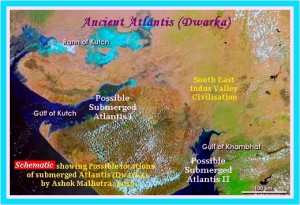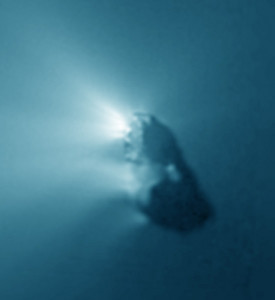Manish Pandit
Dwarka
 Dwarka, which means ‘door’ in Sanskrit, is a city in North-West India in the state of Gujarat. Today’s Dwarka is the seventh to bear this name, the previous six having been successively submerged. The original city is referred to throughout the Hindu scriptures and was once the capital of Krishna, the Hindu deity(h).
Dwarka, which means ‘door’ in Sanskrit, is a city in North-West India in the state of Gujarat. Today’s Dwarka is the seventh to bear this name, the previous six having been successively submerged. The original city is referred to throughout the Hindu scriptures and was once the capital of Krishna, the Hindu deity(h).
Similarly, the submerged city of Mahabalipuram on the other side of the country would seem to have suffered in the same way, although Dr Glenn Milne, from Durham University, dates that particular submergence to 4000 BC± 1000 years(c). In early 2016 it was announced(d) that one of the legendary Six Pagodas of Mahabalipuram has been discovered. Others have suggested that the sunken cities of Cambay may be even older than 9,500 years(g)!
Bibhu Dev Misra is the author of a 2018 paper, in which he explores the idea that the inundation of Dwarka was a consequence of a megatsunami resulting from the cometary impact which created the Burckle Crater in the Indian Ocean(i).
>An Indian astronomy site has an article(j) by Dr Manish Pandit supporting this idea, dating the event to some time between 2800 and 3050 BC and suggesting that the impact was caused by the Comet Soho which was seen in Feb. 3030 BC.<
The search for the ancient Dwarka had been ongoing for some decades until a circular wooden structure was discovered underwater off the coast of Jamnagar. Scientists have dated the original Dwarka to around 2280 BC. Plans have been submitted for the development of the world’s first underwater museum on the site.
Some investigators, including Dr Ashok Malhotra, have suggested that the submergence of Dwarka was the inspiration behind the story of the inundation of Atlantis. Binoy Gupta, a retired government official, subscribes(a) to the same idea but offers little hard evidence to support it.
In August 2016, a blogger, possibly Indian, again proposed that Atlantis and Dwarka were mirror images, adding that Krishna and Hercules were one and the same(e), an idea expanded on elsewhere(f).
(a) https://indianbureaucratsdiary.blogspot.com/2008/02/dwarka-lost-atlantis.html
(b) www.youtube.com/watch?v=Zc2dWngyZH4 & youtube.com/watch?v=NVIsjx5X3QM
(c) See: Archive 2380
(e) See: Archive 3162
(f) Shri Krishna and Hercules – indian and greek mythology – Indian mythology (archive.org)
(h) https://rmiessle.sites.gettysburg.edu/rel-247/vaishnav-krishna/dwarka/ *
Mahabharata
The Mahabharata and The Puranas are two of the ancient epics of Hinduism that refer to events dated between 1500 and 1000 BC and probably developed into their present form between 400 BC and 200 AD. However, Dr Manish Pandit has written three books advocating a date of 3067 BC for the Mahabharata War(e).
These epics make mention of Attala, the white island, a continent located in the western ocean. This vague similarity with the name of Atlantis may be purely coincidental, but it is regularly produced as ‘evidence’ of pre-Platonic reference to Plato’s flooded island.
A brief, but highly speculative attempt to link Atlantis with the Mahabharata is offered by Santosh Kumar(c).
A quite radical suggestion has come from the Italian writer, Michele Manher, who has proposed(a) that Homer’s Iliad originated in India where elements of it can be identified in the Mahabharata!
Wikipedia notes(d) that “the Greek writer Dio Chrysostom (c.40–c.120 CE) reported that Homer’s poetry was being sung even in India. Many scholars have taken this as evidence for the existence of a Mahabharata at this date, whose episodes Dio or his sources identify with the story of the Iliad.”
The website(b) supporting the ‘Atlantis in Indonesia’ theory of Arysio dos Santos has an extensive article with the self-explanatory title of The Hindu Origin of the Myth of Atlantis.
>Sloppy research involving the Mahabharata, produced one of the most dramatic claims of the 20th century, namely, that atomic warfare had taken place in ancient India. In response to thls Joanna Gillan published an article giving a potted history of Mohenjo Daro and including a critical review of those, including David Davenport, who have tried to prove that the site was the location of an ancient nuclear war. Supporters of this idea have pointed to quotations from the Mahabharata in support of this idea. However, Gillan revealed that “Rather than being entirely fictitious, the passage is composed of a merging together of various unrelated passages scattered throughout the 200,000-verse epic, some of which are also questionable English translations of a questionable French translation of the original Sanskrit. When viewed in their original context, they are a little less convincing.”(f)<
(a) https://www.migration-diffusion.info/article.php?id=100
(b) The Hindu Origin of the Myth of Atlantis | Atlantis (archive.org)
(e) https://astronomyofindia.wordpress.com/2020/12/29/3067bce-dissection-of-theories-on-the-mahabharata/
(f) Was the Mohenjo Daro ‘Massacre’ Real? | Ancient Origins (ancient-origins.net) *
Halley’s Comet
Halley’s Comet is named after Edmond Halley (1656-1742) who correctly  predicted its periodicity and that it would return after his death in 1759. Bill Arnett has advised that “The average period of Halley’s orbit is 76 years but you cannot calculate the dates of its reappearances by simply subtracting multiples of 76 years from 1986. The gravitational pull of the major planets alters the orbital period from revolution to revolution. Nongravitational effects (such as the reaction from gasses boiled off during its passage near the Sun) also play an important, but smaller, role in altering the orbit. Between the years 239 BC and 1986 AD the orbital period has varied from 76.0 years (in 1986) to 79.3 years (in 451 and 1066).“(q)
predicted its periodicity and that it would return after his death in 1759. Bill Arnett has advised that “The average period of Halley’s orbit is 76 years but you cannot calculate the dates of its reappearances by simply subtracting multiples of 76 years from 1986. The gravitational pull of the major planets alters the orbital period from revolution to revolution. Nongravitational effects (such as the reaction from gasses boiled off during its passage near the Sun) also play an important, but smaller, role in altering the orbit. Between the years 239 BC and 1986 AD the orbital period has varied from 76.0 years (in 1986) to 79.3 years (in 451 and 1066).“(q)
In 1694 Halley proposed(f) that Noah’s Flood had been caused by a cometary impact, a suggestion for which he was censured by the Royal Society. However, he was rather off the mark when he was the first to propose a ‘hollow Earth’ in 1692(c).
Although the comet’s average orbital period is 76 years, it has been as high as 79.3 years. The nucleus of Halley’s Comet is approximately 5x5x10 miles but has a very low density. The earliest observation of the comet was noted in 240 BC by the Chinese, although there is now a suggestion of 466 BC being the earliest reference in ancient Greek records(e). It has also been famously recorded on the Bayeux Tapestry, mentioned in the Talmud and frequently associated with the Star of Bethlehem(h).
A more recent suggestion has been that a fragment of HC hit the Earth in 536 AD lowering temperatures globally causing drought, famine and disease(g).
Polish Professor Kamienski considered the biblical mention of ‘an angel with a sword’ (1Chron 21.16) to be a reference to Halley’s appearance around 1010 BC. However, Kamienski dated another close encounter with Halley’s Comet, which led to the destruction of Atlantis, to circa 9550 BC. In a similar fashion, the historian Donald V. Etz in 1986(b) argued that Isaiah 14.12-15 was possibly inspired by the appearance of the same comet.
 Halley’s comet was considered a harbinger of doom as its appearance seemed to eerily coincide with various disasters, both natural and military.
Halley’s comet was considered a harbinger of doom as its appearance seemed to eerily coincide with various disasters, both natural and military.
In 1956, Kamienski then entered the contentious matter of the date of the Trojan War, which he proposed had ended circa 1165 BC and suggested that it may have coincided with the appearance of Halley’s Comet!(o)
Halley’s Comet, in fact, comets generally, were considered to be harbingers of doom, as their appearance seemed to eerily coincide with various disasters, both natural and military.
In 1456, Pope Calixtus III excommunicated the comet as an agent of Satan. This appears to have been theologically unsound as the comet was never a member of the Church in the first place. Amazingly, comets have continued to reappear, obviously concurrent with a least one of the daily earthbound calamities that is our lot.
The French astronomer Nicolas Camille Flammarion predicted that the appearance of Halley’s Comet in 1910 would fill the earth’s atmosphere with toxic gas and kill all life on earth! Obviously, nothing catastrophic happened then nor on its next visit in 1986.
Another suggested date for Halley’s Comet leading to the demise of Atlantis is 1628 BC put forward by David Wiseman, a Bible teacher(d).
Jean Silvain Bailly was the first to compute the orbit of the comet and coincidentally also wrote on the subject of Atlantis at the end of the 18th century.
Col. Braghine theorised that Atlantis was destroyed as a result of a close encounter of the Earth with Halley’s Comet and similarly the Polish Professor Kamienski suggested that a large chunk of Halley’s Comet fell into the Gulf of Mexico in 9542 BC. Kamienski has also written very technical paper(a) on the 2320 BC appearance of the comet. The American astronomer Jack Hills, an asteroid specialist at the Los Alamos National Laboratory holds similar views to Kamienski.
>The earliest claimed sighting of Halley’s Comet appears to have come from Dr Manish Pandit, who has proposed that it was seen as early as 3067 BC(p).<
Halley’s Comet has also been blamed for the disappearance of the Pannonian Lake, another proposed Atlantis location.
Jürgen Spanuth thought that Phaëton was a fragment of Halley’s Comet. Two other followers of Spanuth, Günter Bischoff and Walter Stender have written extensive papers, in German, on a meteorite impact with Northern Europe around 1220 BC, which they also identified as Phaëton(j)(n). The same interpretation has been applied specifically to Lake Chiemgau in S.E. Bavaria and is expanded on in papers by Barbara Rappenglück among many others(k)(l)(m).
In a 2018 paper(i), Charles A Rogers associates Phaëton with Halley’s Comet, dating the close encounter to 1404 BC. He goes further, linking the ‘pillar of light’ in Exodus with both Halley’s Comet and the eruption of Thera. He then proceeds to connect this event(s) with the destruction of Atlantis on the Gulf of Gabes at the mouth of the River Triton!
Clube & Napier in The Cosmic Winter [290]suggested that the Biblical Exodus story contains the earliest reference to Halley’s Comet. The controversial Jeffrey Goodman also links a number of Biblical events with cometary encounters in The Comets of God [1687].
For trivia lovers, I note that both the birth (1835) and death (1910) of the writer Mark Twain coincided with appearances of Halley’s Comet!
(a) http://articles.adsabs.harvard.edu//full/1956AcA…..6….3K/0000003.000.html
(b) https://www.jstor.org/pss/1518410
(c) https://dioi.org/kn/halleyhollow.htm
(d) See Archive 3339
(e) https://baringtheaegis.blogspot.ie/2014/07/a-recorded-ancient-hellenic-sighting-of.html
(f) https://www.jasoncolavito.com/halley-on-noahs-comet.html
(g) https://www.q-mag.org/fragment-of-halleys-comet-hit-earth-in-536-a-d-causing-drought-and-famine.html
(h) https://ufosightingshotspot.blogspot.ie/2017/05/earth-entering-debris-field-from.html
(i) https://www.academia.edu/36855091/Atlantis_Once_Lost_Now_Found
(j) https://www.efodon.de/html/archiv/vorgeschichte/bischoff/2003-SY5%20bischoff_phaeton.pdf
(k) http://impact-structures.com/news/Stoettham_c.pdf
(m) https://guginew.blogspot.ie/2011/09/fall-of-phaethon-greco-roman-geomyth.html
(o) Atlantis, Volume 10 No. 3, March 1957
